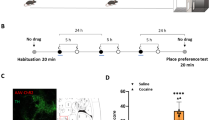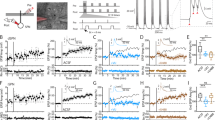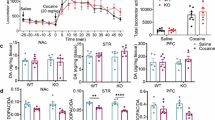Abstract
In the striatum, signaling through G protein-coupled dopamine receptors mediates motor and reward behavior, and underlies the effects of addictive drugs. The extent of receptor responses is determined by RGS9-2/Gβ5 complexes, a striatally enriched regulator that limits the lifetime of activated G proteins. Recent studies suggest that the function of RGS9-2/Gβ5 is controlled by the association with an additional subunit, R7BP, making elucidation of its contribution to striatal signaling essential for understanding molecular mechanisms of behaviors mediated by the striatum. In this study, we report that elimination of R7BP in mice results in motor coordination deficits and greater locomotor response to morphine administration, consistent with the essential role of R7BP in maintaining RGS9-2 expression in the striatum. However, in contrast to previously reported observations with RGS9-2 knockouts, mice lacking R7BP do not show higher sensitivity to locomotor-stimulating effects of cocaine. Using a striatum-specific knockdown approach, we show that the sensitivity of motor stimulation to cocaine is instead dependent on RGS7, whose complex formation with R7BP is dictated by RGS9-2 expression. These results indicate that dopamine signaling in the striatum is controlled by concerted interplay between two RGS proteins, RGS7 and RGS9-2, which are balanced by a common subunit, R7BP.
Similar content being viewed by others
Log in or create a free account to read this content
Gain free access to this article, as well as selected content from this journal and more on nature.com
or
References
Anderson GR, Lujan R, Martemyanov KA (2009a). Changes in striatal signaling induce remodeling of RGS complexes containing Gbeta5 and R7BP subunits. Mol Cell Biol 29: 3033–3044.
Anderson GR, Lujan R, Semenov A, Pravetoni M, Posokhova EN, Song JH et al (2007b). Expression and localization of RGS9-2/Gbeta5/R7BP complex in vivo is set by dynamic control of its constitutive degradation by cellular cysteine proteases. J Neurosci 27: 14117–14127.
Anderson GR, Posokhova E, Martemyanov KA (2009b). The R7 RGS protein family: multi-subunit regulators of neuronal G protein signaling. Cell Biochem Biophys 54: 33–46.
Anderson GR, Semenov A, Song JH, Martemyanov KA (2007a). The membrane anchor R7BP controls the proteolytic stability of the striatal specific RGS protein, RGS9-2. J Biol Chem 282: 4772–4781.
Blundell J, Hoang CV, Potts B, Gold SJ, Powell CM (2008). Motor coordination deficits in mice lacking RGS9. Brain Res 1190: 78–85.
Bouhamdan M, Yan HD, Yan XH, Bannon MJ, Andrade R (2006). Brain-specific regulator of G-protein signaling 9-2 selectively interacts with alpha-actinin-2 to regulate calcium-dependent inactivation of NMDA receptors. J Neurosci 26: 2522–2530.
Brandon EP, Logue SF, Adams MR, Qi M, Sullivan SP, Matsumoto AM et al (1998). Defective motor behavior and neural gene expression in RIIbeta-protein kinase A mutant mice. J Neurosci 18: 3639–3649.
Burchett SA (2005). Psychostimulants, madness, memory, and RGS proteins? Neuromolecular Med 7: 101–127.
Cabrera-Vera TM, Hernandez S, Earls LR, Medkova M, Sundgren-Andersson AK, Surmeier DJ et al (2004). RGS9-2 modulates D2 dopamine receptor-mediated Ca2+ channel inhibition in rat striatal cholinergic interneurons. Proc Natl Acad Sci USA 101: 16339–16344.
Chen CK, Eversole-Cire P, Zhang HK, Mancino V, Chen YJ, He W et al (2003). Instability of GGL domain-containing RGS proteins in mice lacking the G protein beta-subunit Gbeta5. Proc Natl Acad Sci USA 100: 6604–6609.
Coleman JE, Huentelman MJ, Kasparov S, Metcalfe BL, Paton JF, Katovich MJ et al (2003). Efficient large-scale production and concentration of HIV-1-based lentiviral vectors for use in vivo. Physiol Genomics 12: 221–228.
Costa RM, Cohen D, Nicolelis MA (2004). Differential corticostriatal plasticity during fast and slow motor skill learning in mice. Curr Biol 14: 1124–1134.
Dang MT, Yokoi F, Yin HH, Lovinger DM, Wang Y, Li Y (2006). Disrupted motor learning and long-term synaptic plasticity in mice lacking NMDAR1 in the striatum. Proc Natl Acad Sci USA 103: 15254–15259.
Davidson S, Truong H, Nakagawa Y, Giesler GJ (2010). A microinjection technique for targeting regions of embryonic and neonatal mouse brain in vivo. Brain Res 1307: 43–52.
DeLong MR, Wichmann T (2007). Circuits and circuit disorders of the basal ganglia. Arch Neurol 64: 20–24.
Drenan RM, Doupnik CA, Boyle MP, Muglia LJ, Huettner JE, Linder ME et al (2005). Palmitoylation regulates plasma membrane-nuclear shuttling of R7BP, a novel membrane anchor for the RGS7 family. J Cell Biol 169: 623–633.
Drenan RM, Doupnik CA, Jayaraman M, Buchwalter AL, Kaltenbronn KM, Huettner JE et al (2006). R7BP augments the function of RGS7/Gbeta5 complexes by a plasma membrane-targeting mechanism. J Biol Chem 281: 28222–28231.
Fernagut PO, Chalon S, Diguet E, Guilloteau D, Tison F, Jaber M (2003). Motor behaviour deficits and their histopathological and functional correlates in the nigrostriatal system of dopamine transporter knockout mice. Neuroscience 116: 1123–1130.
Fowler SC, Zarcone TJ, Vorontsova E, Chen R (2002). Motor and associative deficits in D2 dopamine receptor knockout mice. Int J Dev Neurosci 20: 309–321.
Gainetdinov RR, Premont RT, Bohn LM, Lefkowitz RJ, Caron MG (2004). Desensitization of G protein-coupled receptors and neuronal functions. Annu Rev Neurosci 27: 107–144.
Gold SJ, Hoang CV, Potts BW, Porras G, Pioli E, Kim KW et al (2007). RGS9-2 negatively modulates L-3,4-dihydroxyphenylalanine-induced dyskinesia in experimental Parkinson's disease. J Neurosci 27: 14338–14348.
Grabowska D, Jayaraman M, Kaltenbronn KM, Sandiford SL, Wang Q, Jenkins S et al (2008). Postnatal induction and localization of R7BP, a membrane-anchoring protein for regulator of G protein signaling 7 family-Gbeta5 complexes in brain. Neuroscience 151: 969–982.
Groenewegen HJ (2003). The basal ganglia and motor control. Neural Plast 10: 107–120.
Hollinger S, Hepler JR (2002). Cellular regulation of RGS proteins: modulators and integrators of G protein signaling. Pharmacol Rev 54: 527–559.
Hooks SB, Waldo GL, Corbitt J, Bodor ET, Krumins AM, Harden TK (2003). RGS6, RGS7, RGS9, and RGS11 stimulate GTPase activity of Gi family G-proteins with differential selectivity and maximal activity. J Biol Chem 278: 10087–10093.
Hyman SE, Malenka RC, Nestler EJ (2006). Neural mechanisms of addiction: the role of reward-related learning and memory. Annu Rev Neurosci 29: 565–598.
Jayaraman M, Zhou H, Jia L, Cain MD, Blumer KJ (2009). R9AP and R7BP: traffic cops for the RGS7 family in phototransduction and neuronal GPCR signaling. Trends Pharmacol Sci 30: 17–24.
Kovoor A, Seyffarth P, Ebert J, Barghshoon S, Chen CK, Schwarz S et al (2005). D2 dopamine receptors colocalize regulator of G-protein signaling 9-2 (RGS9-2) via the RGS9 DEP domain, and RGS9 knock-out mice develop dyskinesias associated with dopamine pathways. J Neurosci 25: 2157–2165.
Kreitzer AC (2009). Physiology and pharmacology of striatal neurons. Annu Rev Neurosci 32: 127–147.
Kreitzer AC, Malenka RC (2008). Striatal plasticity and basal ganglia circuit function. Neuron 60: 543–554.
Martemyanov KA, Yoo PJ, Skiba NP, Arshavsky VY (2005). R7BP, a novel neuronal protein interacting with RGS proteins of the R7 family. J Biol Chem 280: 5133–5136.
Meyer DA, Richer E, Benkovic SA, Hayashi K, Kansy JW, Hale CF et al (2008). Striatal dysregulation of Cdk5 alters locomotor responses to cocaine, motor learning, and dendritic morphology. Proc Natl Acad Sci USA 105: 18561–18566.
Narayanan V, Sandiford SL, Wang Q, Keren-Raifman T, Levay K, Slepak VZ (2007). Intramolecular interaction between the DEP domain of RGS7 and the Gbeta5 subunit. Biochemistry 46: 6859–6870.
Nestler EJ (2005). Is there a common molecular pathway for addiction? Nat Neurosci 8: 1445–1449.
Nicola SM, Surmeier J, Malenka RC (2000). Dopaminergic modulation of neuronal excitability in the striatum and nucleus accumbens. Annu Rev Neurosci 23: 185–215.
Packard MG, Knowlton BJ (2002). Learning and memory functions of the Basal Ganglia. Annu Rev Neurosci 25: 563–593.
Paxinos G, Halliday G, Watson C, Koutcherov Y, Wang HQ (2007). Atlas of the Developing Mouse Brain. Elsevier: Amsterdam, The Netherlands.
Pierce RC, Kumaresan V (2006). The mesolimbic dopamine system: the final common pathway for the reinforcing effect of drugs of abuse? Neurosci Biobehav Rev 30: 215–238.
Pisani A, Centonze D, Bernardi G, Calabresi P (2005). Striatal synaptic plasticity: implications for motor learning and Parkinson's disease. Mov Disord 20: 395–402.
Pravetoni M, Wickman K (2008). Behavioral characterization of mice lacking GIRK/Kir3 channel subunits. Genes Brain Behav 7: 523–531.
Psifogeorgou K, Papakosta P, Russo SJ, Neve RL, Kardassis D, Gold SJ et al (2007). RGS9-2 is a negative modulator of mu-opioid receptor function. J Neurochem 103: 617–625.
Rahman Z, Schwarz J, Gold SJ, Zachariou V, Wein MN, Choi KH et al (2003). RGS9 modulates dopamine signaling in the basal ganglia. Neuron 38: 941–952.
Short JL, Ledent C, Drago J, Lawrence AJ (2006). Receptor crosstalk: characterization of mice deficient in dopamine D1 and adenosine A2A receptors. Neuropsychopharmacology 31: 525–534.
Sondek J, Siderovski DP (2001). Ggamma-like (GGL) domains: new frontiers in G-protein signaling and beta-propeller scaffolding. Biochem Pharmacol 61: 1329–1337.
Traynor JR, Terzi D, Caldarone BJ, Zachariou V (2009). RGS9-2: probing an intracellular modulator of behavior as a drug target. Trends Pharmacol Sci 30: 105–111.
Zachariou V, Georgescu D, Sanchez N, Rahman Z, DiLeone R, Berton O et al (2003). Essential role for RGS9 in opiate action. Proc Natl Acad Sci USA 100: 13656–13661.
Acknowledgements
We thank Dr William Simonds (NIH/NIDDKD) for the generous gift of anti- RGS7 and R7BP antibodies. This work was supported by NIH grants DA021743 (KAM), DA026405 (KAM), F31 DA024944 (GRA), NS047399 (GJG), F31 NS047399 (SD), MH061933 (KW), DA011806 (KW), DA019666 (MJT), and a McKnight Land-Grant Award (KAM).
Author information
Authors and Affiliations
Corresponding author
Additional information
DISCLOSURE
The authors declare that except for the income received from the primary employers and NIH grants listed in the ‘Acknowledgements’ section below no financial compensation has been received from any individual or corporate entity over the past 3 years of research or professional service that could be perceived as constituting a potential conflict of interest.
Supplementary Information accompanies the paper on the Neuropsychopharmacology website (http://www.nature.com/npp)
Supplementary information
Rights and permissions
About this article
Cite this article
Anderson, G., Cao, Y., Davidson, S. et al. R7BP Complexes With RGS9-2 and RGS7 in the Striatum Differentially Control Motor Learning and Locomotor Responses to Cocaine. Neuropsychopharmacol 35, 1040–1050 (2010). https://doi.org/10.1038/npp.2009.212
Received:
Revised:
Accepted:
Published:
Issue date:
DOI: https://doi.org/10.1038/npp.2009.212
Keywords
This article is cited by
-
The in vivo specificity of synaptic Gβ and Gγ subunits to the α2a adrenergic receptor at CNS synapses
Scientific Reports (2019)
-
Regulator of G protein signaling 14 (RGS14) is expressed pre- and postsynaptically in neurons of hippocampus, basal ganglia, and amygdala of monkey and human brain
Brain Structure and Function (2018)
-
R7BP Modulates Opiate Analgesia and Tolerance but not Withdrawal
Neuropsychopharmacology (2012)
-
Gβ5-RGS complexes are gatekeepers of hyperactivity involved in control of multiple neurotransmitter systems
Psychopharmacology (2012)



